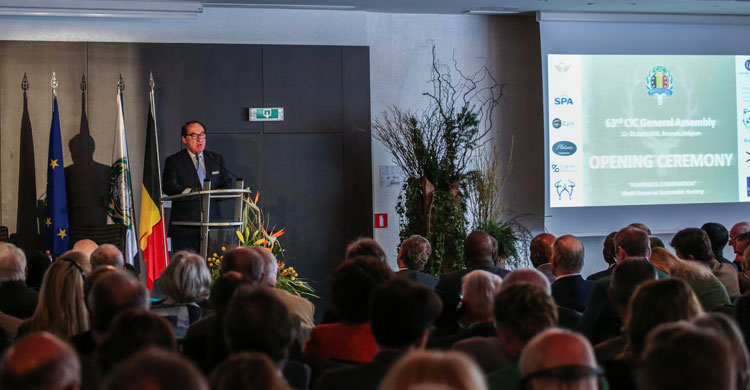CIC General Assembly 63: New Focus on Migratory Birds

CIC 63rd General Assembly, Opening Ceremony - courtesy of the CIC, made by Eszter Gordon
Bonn, 31 May 2016 - Belgium hosted the 63rd General Assembly of the International Council for Game and Wildlife Conservation (CIC) under the slogan “Hunting is Conservation”, from 22 April to 23 April 2016 in Brussels. Some 400 participants from 36 countries from around the world attended the meeting, comprising international organizations, government delegations, hunting organizations, scientists and academics.
The aim of the General Assembly is to foster participation and dialogue amongst CIC members and various stakeholders so as to promote sustainable hunting and sustainable policies for worldwide wildlife management. It also sought to create awareness of wildlife problems, motivate commitment for their solution at the highest level, thus promoting better management of sustainable hunting and wildlife conservation at the local, regional, national and international levels.
“The general conclusion echoed at the meeting was that if hunting is well managed, it can contribute to wildlife conservation and to manage habitats for greater biodiversity”, said Dr. Jacques Trouvilliez, Executive Secretary of the African-Eurasian Migratory Waterbird Agreement (AEWA), who attended the CIC meeting and chaired a side event dedicated to migratory birds - focusing on their international dimension.
In his presentation, Trouvilliez highlighted the successes achieved through the flyway approach and the adaptive management of huntable bird species. During their last Meeting of the Parties in November 2015, the 75 Contracting Parties to AEWA and observers noted that the conservation status of birds could be improved if concerted conservation measures were taken all along the flyway, key sites protected and harvests well managed. “Adaptive management can be applied to declining as well as over-abundant species. This has been successfully done for ducks and geese in North America for many years and we are now starting to apply the lessons learned in Europe as well”, said Trouvilliez.
The European Goose Management Platform currently being developed under AEWA will provide the mechanism for a structured, coordinated and inclusive process of decision-making and implementation for conservation and integrated management, including sustainable use, of goose populations in Europe. Initially covering only a couple of goose species, the mechanism could also be extended to include other waterbird taxa and regions as well as serving as an example for the sustainable management of other harvested species. Not only linked to better management of the harvest of migratory goose populations, the Goose Management Platform is also expected to deal with the coordinated conservation and management of goose populations in general. Measures to be implemented will include tackling threats, site management and site restoration, measuring trends and identifying needs for individual species populations.
“Unfortunately we still don’t have reliable statistics for most countries of the African-Eurasian Flyway”, underlined Trouvilliez.
In order to provide the Parties of the Agreement with the best science-based recommendations, the AEWA Technical Committee brings together regional experts in bird conservation and sustainable use and representatives of organizations such as the CIC and BirdLife international.
Amongst other participants to the side-event, Alexandre Czajkowski, Director of the European Institute of Wild Birds and their Habitats (OMPO) illustrated this flyway approach with results from scientific works conducted in Eastern Europe, Russia and Africa. To provide the best scientific knowledge, OMPO together with national academic institutions conducts programmes on waterbirds and thrushes. Trends in populations, breeding success and determination of migration routes are key elements to adaptive management.
Evgeny Syroechkovski, Senior Advisor at the All-Russian Institute for Ecology, demonstrated that conservation of threatened waterbird populations in East Asia is the first priority as wetlands are globally disappearing at an increasing rate, particularly in the Yellow Sea where harvest is currently not sustainable along the East-Asian Australasian Flyway.
Christian Krogell, Deputy Director-General of the Department of Natural Resources, Finnish Ministry of Agriculture and Forestry, and Jarkko Nurmi, Director of Sustainable Wildlife Management at the Finnish Wildlife Agency, presented their country’s initiative to involve the land owners, farmers and hunters in biodiversity conservation. Through these partnerships these people can make a difference on the ground and provide suitable habitats for wildlife.
During the discussion which followed the presentations, the participants recognized the necessity of the flyway approach and expressed their wish to engage the CIC in a more prominent manner in migratory bird conservation for the benefit of hunters, birds and habitats.
The International Council for Game and Wildlife Conservation, as the global platform of the hunting community, is also a key partner of World Migratory Bird Day, a global awareness-raising campaign run by the Convention on the Conservation of Migratory Species of Wild Animals (CMS) and the Agreement on the Conservation of African-Eurasian Migratory Waterbirds (AEWA). The theme in 2016 was the illegal killing, taking and trade of migratory birds.
“To this day, migratory birds play an important role in the CIC’s work”, said George Aman, President of CIC. “It is well known that well-regulated, sustainable hunting is an important component of conservation, since it includes demonstrable actions against illegal killing, taking, and trade of migratory birds. Therefore, combatting wildlife crime is one of the four strategic initiatives of the CIC”.
Last updated on 31 October 2018


